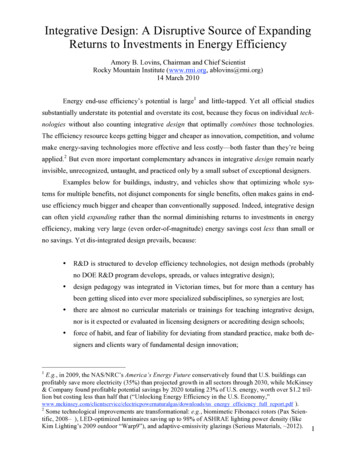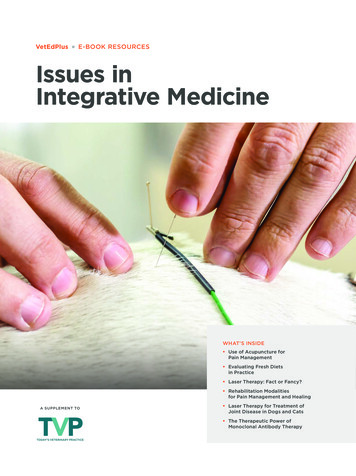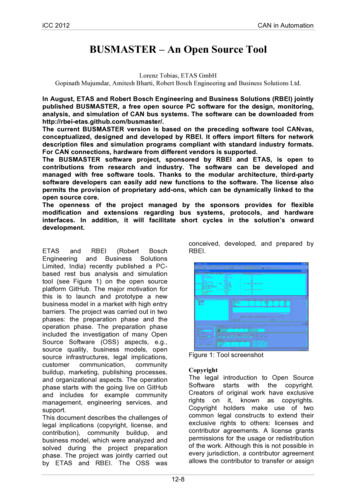
Transcription
Integrative Design: A Disruptive Source of ExpandingReturns to Investments in Energy EfficiencyAmory B. Lovins, Chairman and Chief ScientistRocky Mountain Institute (www.rmi.org, ablovins@rmi.org)14 March 2010Energy end-use efficiency’s potential is large1 and little-tapped. Yet all official studiessubstantially understate its potential and overstate its cost, because they focus on individual technologies without also counting integrative design that optimally combines those technologies.The efficiency resource keeps getting bigger and cheaper as innovation, competition, and volumemake energy-saving technologies more effective and less costly—both faster than they’re beingapplied.2 But even more important complementary advances in integrative design remain nearlyinvisible, unrecognized, untaught, and practiced only by a small subset of exceptional designers.Examples below for buildings, industry, and vehicles show that optimizing whole systems for multiple benefits, not disjunct components for single benefits, often makes gains in enduse efficiency much bigger and cheaper than conventionally supposed. Indeed, integrative designcan often yield expanding rather than the normal diminishing returns to investments in energyefficiency, making very large (even order-of-magnitude) energy savings cost less than small orno savings. Yet dis-integrated design prevails, because: R&D is structured to develop efficiency technologies, not design methods (probablyno DOE R&D program develops, spreads, or values integrative design); design pedagogy was integrated in Victorian times, but for more than a century hasbeen getting sliced into ever more specialized subdisciplines, so synergies are lost; there are almost no curricular materials or trainings for teaching integrative design,nor is it expected or evaluated in licensing designers or accrediting design schools; force of habit, and fear of liability for deviating from standard practice, make both designers and clients wary of fundamental design innovation;1E.g., in 2009, the NAS/NRC’s America’s Energy Future conservatively found that U.S. buildings canprofitably save more electricity (35%) than projected growth in all sectors through 2030, while McKinsey& Company found profitable potential savings by 2020 totaling 23% of U.S. energy, worth over 1.2 trillion but costing less than half that (“Unlocking Energy Efficiency in the U.S. powernaturalgas/downloads/us energy efficiency full report.pdf ).2Some technological improvements are transformational: e.g., biomimetic Fibonacci rotors (Pax Scientific, 2008– ), LED-optimized luminaires saving up to 98% of ASHRAE lighting power density (likeKim Lighting’s 2009 outdoor “Warp9”), and adaptive-emissivity glazings (Serious Materials, 2012). 1
most software design tools optimize parts, not wholes, and cannot support integrativedesign, nor is there a readily identifiable and skilled integrative design practice fromwhich tool-builders can extract the necessary insights; design practice has become commoditized, so most clients expect, reward, and getminor adaptations of previous drawings, not clean-sheet whole-system optimization.These mutually reinforcing causes create a vicious circle reinforcing the status quo. Reversal requires a concerted effort to replace disciplinary fragmentation with a clear whole-system designmethodology; new teaching materials (including practical case-studies) and teacher training; collaboration between design clients, firms, and schools to create “demand pull”; rewarding designers for what they save, not what they spend; early-adopter clients’ offering liability waivers orrisk-sharing to overcome hesitancy; wide dissemination of results to build broad acceptance; andrapid feedback from field results to keep improving pedagogy and practice.Integrative designIntegrative design rigorously applies orthodox engineering principles, but achieves radically more energy- and resource-efficient results by asking different questions that change thedesign logic. Scattered but encouraging examples have lately emerged in hundreds of buildingsas well as in several vehicle designs and diverse industrial facilities, both new and retrofit. Integrative design was validated by an 18-million 1990–97 Pacific Gas and Electric Company experiment3 and taught at Stanford Engineering School in 2007.4 Yet it remains rarely practiced orrecognized:5 the National Academies’ America’s Energy Future mentions its potential value forbuildings but ignores its effect, and ignores it altogether for vehicles and industry. Such omissions of integrative design, perhaps due to relative unfamiliarity, make energy efficiency’s potential seem smaller and costlier than it really is, so huge investments are misallocated to supply.To be sure, integrative design isn’t easy at first: it requires designers with diverse backgrounds and synthetic as well as analytic talents, a transdisciplinary team, a demanding client,and meticulous attention to detail. But experience demonstrates that it can be done, it can betaught, with practice it becomes as easy as dis-integrated design is now, and in the long run, itmay become a key determinant of competitive success.3Brohard, G.J. et al. 1998: “Advanced Customer Technology Test for Maximum Energy Efficiency(ACT2) Project: The Final Report.” Procs. Summer Study on Energy-Efficient Buildings, ACEEE,207.67.203.54/elibsql05 p40007 documents/ACT2/act2fnl.pdf; technical reports atwww.pge.com/pec/resourcecenter/, “Related Links.”45“Advanced Energy Efficiency”; the five public-lecture podcasts are at itunes.stanford.eduWith minor exceptions, chiefly in DoD, GSA, and the Federal Energy Management Program. 2
Economic theory generally assumes diminishing returns: the more efficiency we buy, themore steeply the marginal cost of the next increment of savings rises, until it becomes too costly(Fig. 1a). But integrative engineering often yields expanding returns—big savings can cost lessthan small or no savings (Fig. 1b)—if the engineering is done unconventionally but properly.Fig. 1a (left). Diminishing returns are normally assumed for all components but observedonly for some, like thermal insulation—and not for others, like refrigerators, TVs, servers,midsize industrial pumps, and motors up to at least 350 hp. Fig. 1b (right) shows how, ifwe optimize not components for single benefits but whole systems for multiple benefits, wecan often make big savings cost less than small ones, as illustrated on pp. 4–8 below.Integrative design applies clear principles that are often ignored and seldom combined:1. Focusing on the desired end-use places purposes and application before equipment, efficiency before supply, passive before active, simple before complex.2. Broadening design scope embraces whole systems and sets end-use performance metrics.3. Designing from scratch, at least initially, creatively harnesses “beginner’s mind,” spansdisciplinary silos, surpasses traditional solutions, and further expands the design space.4. Analyzing gaps between theoretical minimum requirements and typical usage revealsoverlooked opportunities for elegant frugality.5. Optimizing systems, not isolated parts, lets single expenditures yield multiple benefits.6. Evidence-based analysis supplants rules of thumb.7. Measurement and prudence replace mindless oversizing and allow operational risks to bemanaged explicitly and intelligently.8. End-use savings multiply upstream energy and capital savings, so efficiency logic is sequenced in the direction opposite to energy flow.9. Design satisfies rare conditions (making appropriate tradeoffs and engaging end-users),but emphasizes typical conditions to maximize performance integrated over the range.10. Controls and embedded sensors create intelligence and learning, so design can be optimized in real operation and further improved in future applications.The following examples illustrate these principles.3
Examples in buildingsHow much thermal insulation should surround a house in a cold climate? All engineeringtexts (at least in English) say to specify just the thickness that will repay its marginal cost fromthe present value of the saved marginal heating energy. But this omits the capital cost of theheating system—furnace, ducts, fans, pipes, pumps, wires, controls, and fuel source. A 1984 subarctic-climate house so optimized saved 99% of its space-heating energy with 1,100 lowerconstruction cost, because superwindows, superinsulation, air-to-air heat exchangers, etc. costless than the heating system they replaced. This approach has also been adopted in 20,000 EUand US “passive houses,” saving 75–95% of US-allowable heating energy with no extra capex.Similarly, PG&E’s “ACT2” experiment demonstrated in seven new and old buildings inthe 1990s6 that the “supply curve” of energy efficiency generally bent downwards as sketched inFigure 1b. For example, an ordinary-looking new tract house was designed in 1994 to save 82%of the energy allowed by the then-strictest US standard (1992 California Title 24), yet PG&E estimated that if built in quantity, it would cost 1,800 less than normal to build and 1,600 lessin present value to maintain.7 It provided normal or better comfort with no cooling system in aclimate that can reach 113 F; a similar house later did the same in a 115 F-peak climate. And the1996 Bangkok house of architect Prof. Suntoorn Boonyatikarn provided superior comfort, with 10% of normal air-conditioning energy, at no extra construction cost.8 This and the coldclimate house example essentially span the range of the Earth’s inhabited climates.A retrofit now underway at the Empire State Building is expected to save 38% of its energy with a 3-year payback: remaking its 6,500 windows onsite into superwindows (nearly perfect in admitting light without heat), plus lighting retrofits, cut the peak cooling load by onethird, saving 17.4 million capex because the old chillers can be renovated and reduced ratherthan replaced and expanded.9 This reveals the opportunity to make deep retrofits cheaper by coordinating with routine renovations like renewing curtainwalls. Such a retrofit design for a200,200-ft2 all-glass office tower near Chicago found 75% energy-saving potential at slightlylower cost than the normal 20-year reglazing that saves nothing—because the 200,000 capexsaved by making the cooling system 4! smaller (yet 4! more efficient), not renovating the big6Ref. 3, supra.Davis Residential Site Design Report, 1996 (n. 3 above, last reference); “The Super-EfficientPassive Building Frontier,” ASHRAE J. 37(6):79–81, June 1995.8www.e2singapore.gov.sg/docs/Seminar Buildings.pdf.9N. Buhayar, “Old Wine, New Bottles,” Wall St. J., 21 Sept. 2009,online.wsj.com/article/NA WSJ ml (misprinting 17.4 million as 7 million of saved capex).47
old system, pays for the other improvements.10 However, that design wasn’t implemented because of a perversely incentivized leasing broker—a reminder of the need for systematic implementation follow-through to overcome obstacles at each stage of the complex value chain.Digging deeper: a pumping-system exampleMotors use 60% of the world’s electricity. Half of motor power runs pumps and fans.Many pumps circulate fluids in factories and buildings. Such a heat-transfer loop originally designed to use 70.8 kW of pumping power was redesigned by Interface Nederland’s chief engineer Jan Schilham to use !9.7 kW—"86% less—with lower capital cost and better performance,using no new technologies but only two changes in the design mentality: Use big pipes and small pumps, not small pipes and big pumps. Pipe friction falls asnearly the fifth power of diameter. Conventional design makes the pipe just fat enough torepay its greater cost from the saved pumping energy over the years. But this omits thecapital cost of the pumping equipment—the pump, motor, inverter, and electricals—thatmust overcome the pipe friction. Their size and roughly their cost falls as nearly the fifthpower of pipe diameter; the cost of the fatter pipe rises as only the second power of diameter. Thus optimizing the pipe as a component pessimizes the system. Optimizing thewhole system yields fat pipes and small pumps, with smaller total capex and tiny opex. Lay out the pipes first, then the equipment. Normal practice is the opposite, makingthe connected equipment typically far apart, obstructed by other objects, at the wrongheight, and facing the wrong way, so the piping has 3–6! as much friction as it wouldwith a straight shot. The pipefitters like this: they are paid by the hour, mark up a profiton the extra pipes and fittings, and don’t pay for the extra electricity or bigger pumpingequipment. A smart owner prefers fat, short, straight pipes to thin, long, crooked pipes.These design changes cut reported pumping power by "7!, with lower capital cost and betterperformance—and saved 70 kW of heat loss with a 2-month payback by facilitating insulation.The engineer who inspired Schilham’s innovations recently designed the pumping systemin Fig. 2 (next page). Piping is usually laid out orthogonally—at neat right angles—which is easyto draw but maximizes friction and cost. Nowadays the drawing is usually done by computers,whose CAD software will soon be able to create such non-orthogonal designs. That’s unorthodoxand less pretty, but far more economical.10ASHRAE J., ref. 7, supra.5
Fig. 2: A 2009 Singapore piping system by LEE Eng Lock, saving 69% of normalpumping energy with reduced capex (partly because of the smaller pumps and motors).These pumping examples hold another key lesson (Fig. 3 on next page): each unit of friction orflow saved in the piping system saves 10 units of fuel, emissions, and cost at the power plant,because the 10! compounding losses from power-plant fuel to pipe flow are turned aroundbackwards into compounding savings. Starting savings downstream also makes the upstreamcomponents progressively smaller, simpler, and cheaper, saving the most capital cost too.Industrial examplesRecent integrative redesigns of diverse industrial plants have typically yielded retrofit energysavings 30–60% with paybacks of a few years, and new-facility energy savings 40–90% withgenerally lower capital cost. For example: a 2009 EDS data center is using 73% less non-IT electricity and 98% less cooling andpumping energy than normal, with 3! the computing/kW, at normal capital cost—but itsfull potential would have saved 95% of the electricity and 50% of the capital cost;1111tinyurl.com/yfd95ua; tinyurl.com/ykd5b5s; www.youtube.com/watch?v edfiles/Responses/53539/9469/EDS SustainableDC.pdf;EDS staff, personal communications.6
Fig. 3: Saving downstream energy turns compounding losses into compounding savings ofenergy and capital. Reproduced by permission from Scientific American, 9/05, pp. 74–83. TI’s Richardson, Texas chip fab saved 20% of the energy (without using the two biggestrecommendations, delayed to later fabs), 35% of water, and 230M (30%) of capitalcost12—while the conceptual design for another firm’s next fab is expected to save twothirds of energy and half of capex while eliminating all 22,000 tons of chillers;13 a retrofit underway at the world’s #1 platinum mining complex is expected to save 43%of energy with a 2–3-year payback, while a new-iron-mine conceptual design would useno grid electricity or fossil fuel (it runs on gravity) and considerably reduce net capex; retrofit designs for Shell’s most efficient refinery, a giant LNG liquefaction plant, and aNorth Sea platform are respectively expected to save 42%, "40%, and 100% of energywith paybacks of a few years—while a new 5b Fischer-Tropsch gas-to-liquids-plant design is expected to save 50% of energy and 20% of capex.Vehicle examplesSimilar design integration yielded a 3.6! increase in the efficiency of a safe, uncom-promised, gasoline-hybrid midsize SUV, virtually-designed in 2000 with two European TierOnes. Its halved mass didn’t increase production cost, thanks to the two-thirds-smaller powertrain and the novel carbon-fiber manufacturing technology’s savings of 99% in tooling cost and 100% by eliminating body and paint shops. At midvolume production, its 2,511 extra view.shtml.7
price (2000 ) would pay back in one year.14 OEMs are becoming interested: in 2007, Toyota’s1/X concept car combined the interior size of a Prius with half its fuel use and one-third itsweight—and the previous day, Toray announced a factory to mass-produce carbon-fiber car partsfor Toyota. Leapfrogs are starting to appear using both advanced-composite and metal solutions.Such “platform fitness” can greatly accelerate and amplify deployment of any advancedpowertrain by making its costly batteries or fuel cells 3! smaller. For example, a 5-m3, 1-t plugin-hybrid-electric commercial van demonstrated in April 2009 requires no subsidy to make astrong business case to fleet buyers, because its low drag and mass (it weighs the same with a tonof payload as its competitors weigh empty) eliminated most of the costly batteries.15 DOE’sautomotive strategy, in contrast, appears to fund 99% powertrain development and 1% platform fitness. Yet saving one unit of energy in the engine saves just one unit in the tank, whilesaving one unit at the wheels saves eight units in the tank—by eliminating the additional sevenunits that a conventional powertrain would lose while delivering that one unit to the wheels.Next stepsBusiness leaders need to demand radically more efficient design outcomes, and to askmore penetrating questions to ensure that the design process is changed fundamentally, not incrementally. Such “demand pull” can drive basic reforms in engineering pedagogy and practice.Ultimately, this will make profitable integrative design routinely expected—like six-sigma, lean,or safety culture. For now, the potential needs first to be recognized and demanded. Comprehensively applying existing technologies for energy and resource productivity, and developing evenbetter ones, can yield great savings and benefits, but an even bigger prize awaits: There are fewerhigher-leverage opportunities to boost energy productivity than “re-minding” designers.Eight largely completed STMicroelectronics chip-fab retrofits also saved 30–50% of the energy used to make chilled water and clean air, with paybacks typically under one year.14Intl. J. Veh. Des. 35(1/2):50–85 (2004); www.oilendgame.com.15www.brightautomotive.com.813
Kim Lighting’s 2009 outdoor “Warp9”), and adaptive-emissivity glazings (Serious Materials, 2012). 2 most software design tools optimize parts, not wholes, and cannot support integrative design, nor is there a readily










